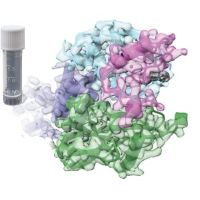Specification
| Description | Recombinant protein from the full-length sequence of homo sapiens flavin containing monooxygenase 5 (FMO5), transcript variant 1 (NM_001461). |
| Organism | Homo sapiens (Human) |
| Expression Host | Human Cells |
| Tag Info | His or DYKDDDDK. Please contact us if you need further information or require specific designed tag. |
| Purity | Greater than 90% by SDS-PAGE gel |
| Uniprot ID | P49326 |
| Entry Name | FMO5_HUMAN |
| Gene Names | FMO5 |
| Alternative Gene Names | |
| Alternative Protein Names | Flavin-containing monooxygenase 5 (FMO 5) (Baeyer-Villiger monooxygenase 1) (hBVMO1) (EC 1.14.13.-) (Dimethylaniline monooxygenase [N-oxide-forming] 5) (EC 1.14.13.8) (Dimethylaniline oxidase 5) (NAPDH oxidase) (EC 1.6.3.1) |
| Application | Antigens, Western, ELISA and other in vitro binding or in vivo functional assays, and protein-protein interaction studies; For research & development use only! |
| Buffer | Purified protein formulated in a sterile solution of PBS buffer, pH7.2, without any preservatives |
| Endotoxin | Endotoxin level is < 0.1 ng/µg of protein (<1EU /µg) |
| Length | 533 |
| Molecular Weight(Da) | 60221 |
| Protein Sequence | (The sequence of expressed protein may have some variation from the sequence shown below. Please contact us for the exact sequence.) MTKKRIAVIGGGVSGLSSIKCCVEEGLEPVCFERTDDIGGLWRFQENPEEGRASIYKSVIINTSKEMMCFSDYPIPDHYPNFMHNAQVLEYFRMYAKEFDLLKYIRFKTTVCSVKKQPDFATSGQWEVVTESEGKKEMNVFDGVMVCTGHHTNAHLPLESFPGIEKFKGQYFHSRDYKNPEGFTGKRVIIIGIGNSGGDLAVEISQTAKQVFLSTRRGAWILNRVGDYGYPADVLFSSRLTHFIWKICGQSLANKYLEKKINQRFDHEMFGLKPKHRALSQHPTLNDDLPNRIISGLVKVKGNVKEFTETAAIFEDGSREDDIDAVIFATGYSFDFPFLEDSVKVVKNKISLYKKVFPPNLERPTLAIIGLIQPLGAIMPISELQGRWATQVFKGLKTLPSQSEMMAEISKAQEEIDKRYVESQRHTIQGDYIDTMEELADLVGVRPNLLSLAFTDPKLALHLLLGPCTPIHYRVQGPGKWDGARKAILTTDDRIRKPLMTRVVERSSSMTSTMTIGKFMLALAFFAIIIAYF |
Background
| Function | FUNCTION: Acts as Baeyer-Villiger monooxygenase on a broad range of substrates. Catalyzes the insertion of an oxygen atom into a carbon-carbon bond adjacent to a carbonyl, which converts ketones to esters (PubMed:28783300, PubMed:26771671, PubMed:20947616). Active on diverse carbonyl compounds, whereas soft nucleophiles are mostly non- or poorly reactive (PubMed:26771671, PubMed:7872795). In contrast with other forms of FMO it is non- or poorly active on 'classical' substrates such as drugs, pesticides, and dietary components containing soft nucleophilic heteroatoms (Probable) (PubMed:7872795). Able to oxidize drug molecules bearing a carbonyl group on an aliphatic chain, such as nabumetone and pentoxifylline (PubMed:28783300). Also, in the absence of substrates, shows slow but yet significant NADPH oxidase activity (PubMed:26771671). Acts as a positive modulator of cholesterol biosynthesis as well as glucose homeostasis, promoting metabolic aging via pleiotropic effects (By similarity). {ECO:0000250|UniProtKB:P97872, ECO:0000269|PubMed:20947616, ECO:0000269|PubMed:26771671, ECO:0000269|PubMed:28783300, ECO:0000269|PubMed:7872795, ECO:0000305|PubMed:26771671}. |
| Pathway | |
| Protein Families | FMO family |
| Tissue Specificity | Expressed in fetal and adult liver. {ECO:0000269|PubMed:7872795, ECO:0000305|PubMed:20947616}. |
QC Data
| Note | Please contact us for QC Data |
| Product Image (Reference Only) |  |

